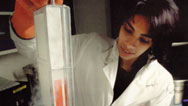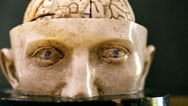Suspended Animation
- By David Levin
- Posted 01.20.11
- NOVA scienceNOW
Stopping signs of life and starting them again might seem like pure sci-fi—but according to cell biologist Mark Roth, it's very possible. Roth says that by carefully using a toxic gas, he can induce suspended animation in small mammals. He's hopeful that the stuff could be used to help save lives in emergency rooms and surgery wards.
Transcript
Suspended Animation
Posted January 20, 2011
DAVID LEVIN: You're listening to a NOVA podcast. I'm David Levin.
Suspended animation shows up in all sorts of movies. Think 2001: A Space Odyssey, or Planet of the Apes—even poor Han Solo in Star Wars. Stopping signs of life and starting them again might seem like pure sci-fi. But in nature, it's very real.
MARK ROTH: Oh no. It's not science fiction. If you look in the animal world, many, many organisms will enter into states of suspended animation.
DAVID LEVIN: That's Mark Roth. He's a scientist at the Fred Hutchinson Cancer Research Center in Seattle.
MARK ROTH: There's no movement. There's no oxygen consumption. And they're fine. For instance, seeds will stop for even hundreds of years, maybe thousands. And spores and cysts of bacteria will stop for, some say, for millions of years.
DAVID LEVIN: Roth studies suspended animation. He says that while it might be second nature for a seed, it's not a state that humans can normally reach.
But sometimes freak accidents can change that.
MARK ROTH: The one that's most striking, for me, is a 29-year-old skier in Norway that was trapped in a waterfall when the water was very cold in the wintertime, when she was out skiing. And she lost heart rate.
DAVID LEVIN: When they found her, she was clinically dead. And for nine hours, she stayed that way.
MARK ROTH: Her core temperature fell from what yours and mine is, is about 37 degrees Centigrade, down to 13 degrees Centigrade.
DAVID LEVIN: That's around 55 degrees Fahrenheit. But as she got warmer, she woke up. Her heart started beating again. And she had no permanent harm. No brain damage.
MARK ROTH: Actually, she went on to be the head radiologist in the hospital that treated her. So she's fine.
DAVID LEVIN: Lots of other people have had similar experiences. They were stuck in cold conditions, and they were basically dead—no breathing, no pulse, no signs of life. But they came back.
So... how?
MARK ROTH: What might be happening in human beings who experience near death is that they are getting cold, but before they get so cold that they would die, they're actually diminishing their oxygen consumption in a way that is unknown. And that extends their survival limits, so they can appear dead but actually not be dead.
DAVID LEVIN: Normally, if your core temperature gets too cold—around 65 degrees Fahrenheit—your heart will stop. If your body isn't getting enough oxygen, your cells shut down, and again, you're a goner. But sometimes, people who experience both low body temperature and low oxygen, like the skier, they survive.
MARK ROTH: For a very long time, we've been extraordinarily interested in the interaction between low temperature and low oxygen. We see that they're connected because we know people who are extremely cold are not getting oxygen to their cells. And yet, they're sometimes alive. So, what's going on there?
DAVID LEVIN: Roth thinks that under the right conditions, something triggers cells to slow down their metabolism. It makes them less hungry for oxygen, so they need less of it to survive.
Just what causes that to happen is a mystery. But Roth had an "a-ha" moment while watching TV. Actually, an episode of NOVA.
MARK ROTH: And, in this program, there were people discussing caves where they found that there was a naturally occurring gas that was in the caves. And this gas was hydrogen sulfide.
DAVID LEVIN: It's a toxic gas, but it has a pretty unique effect on the body. One that caught Roth's attention.
MARK ROTH: What happens is that people get exposed to hydrogen sulfide, and they can have what's called a knock-down. It usually takes one breath. And then they collapse to the ground. They appear dead. But you can move them away from that atmosphere, and then they wake up and they're fine. And this is what was so striking to me, because hydrogen sulfide is produced by the cells of our own body.
DAVID LEVIN: That's right. Your own body makes a substance that's poisonous in large doses. It usually only makes tiny, tiny amounts of it. But Roth thought that somehow, if your cells were producing just a little more hydrogen sulfide than normal, they might have enough to slow down their own metabolism if they got stuck in the cold.
MARK ROTH: This could be a molecule that's regulating our oxygen consumption all the time. And maybe, if you had enough of it around, when you got cold, you could actually turn yourself off before you got so cold that you would die. And that's what we see when we watch these people who have these near-death experiences. They appear dead. But they're actually just suspended.
DAVID LEVIN: Roth has tested this theory in the lab. And by giving just a tiny amount of hydrogen sulfide to small mammals, he could induce a hibernation-like state.
MARK ROTH: You put in hydrogen sulfide and dim the metabolism of the animal, and then take away the hydrogen sulfide, and watch the animal come back.
DAVID LEVIN: That ability to control metabolism could be big deal for medicine. If you can make cells need less oxygen, they can survive longer without it. That little difference in time could help save victims of heart attacks or massive blood loss.
MARK ROTH: Initially, we felt that you could use it in the field to literally buy time for people. If it takes a certain amount of time to die, but you slow people's metabolism down so that, for them, effectively time isn't passing so quickly, then they might survive longer as they are trying to get the critical care they need.
DAVID LEVIN: Roth is still researching the effects of hydrogen sulfide in clinical trials. But he says it looks promising. In some instances, even a tiny dose—way smaller than expected—can bump up survival rates without even knocking a patient out.
MARK ROTH: You know, right now, all we're trying to do is just extract benefit with what I'll call short-term exposure to hydrogen sulfide, briefly slowing things down a little bit, or maybe not even much at all, and still getting benefit in critical care situations.
DAVID LEVIN: If the trials are successful, Roth hopes to see hydrogen sulfide used more widely in hospitals within the next few years.
For NOVA, I'm David Levin.
Credits
Audio
- Produced by
- David Levin
Image
- (Mark Roth)
- © Paul C. Miller
Related Links
-

Human Hibernation
Medical researchers and ER doctors are testing therapies that cool down patients to save their lives.
-

Can We Slow Aging?
A gene called FOXO may be a real elixir of longevity. Can all of us harness its power?
-

Engineering Artificial Organs
Biomedical researcher, MIT professor, and mom, Sangeeta Bhatia says she's just a "regular person."
-

Brain Trauma
Even so-called "mild" head injuries can lead to serious concussions with long-term consequences.
You need the Flash Player plug-in to view this content.




